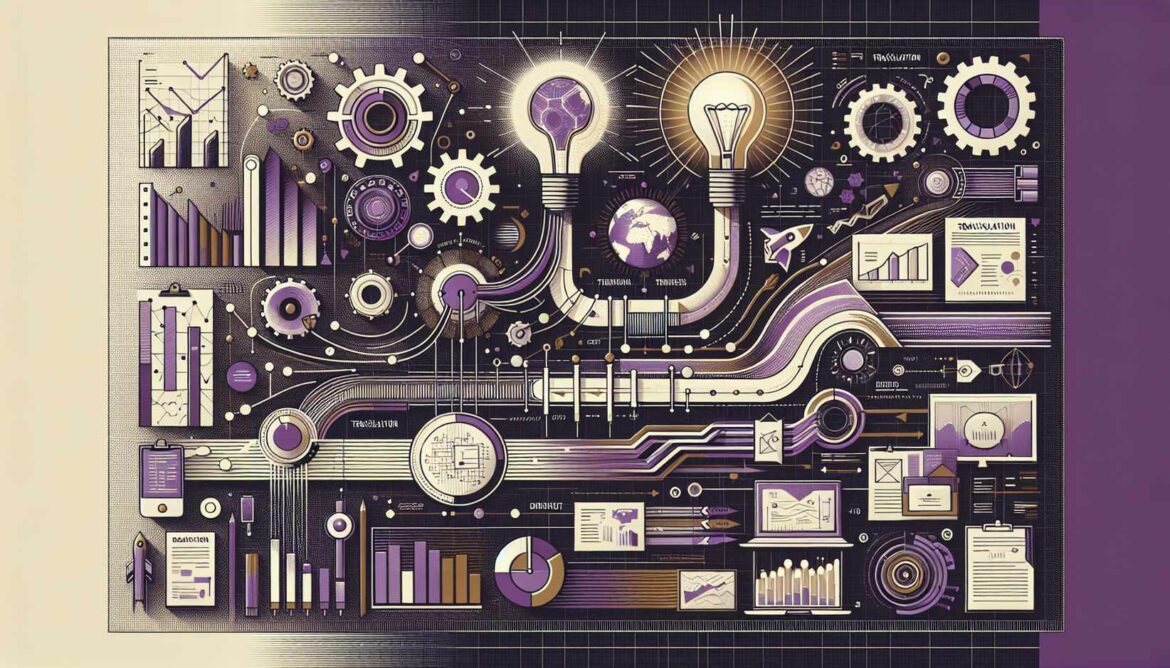Part 1 of 3: Bridging Two Worlds
Business stakeholders speak in outcomes, opportunities, and user experiences. Developers think in databases, APIs, and algorithms. Between these two worlds sits the business analyst, tasked with one of the most challenging jobs in software development: translating vague business ideas into precise technical specifications that developers can actually build. This translation process is both art and science, requiring deep understanding of business needs and technical possibilities.
The stakes couldn’t be higher. Poor translation leads to software that technically works but fails to solve business problems. Missed nuances result in expensive rework. Misunderstood priorities create features nobody uses. Master this translation process, and you become the crucial bridge that turns business vision into technical reality.
The Translation Challenge
The difficulty of translating business ideas into technical specs isn’t just about language—it’s about fundamental differences in how business stakeholders and technical teams think about problems and solutions.
Business Thinking vs. Technical Thinking
Business stakeholders think in terms of user outcomes, market opportunities, and competitive advantages. They care about what the system should accomplish and why it matters for business success.
Technical teams think in terms of data structures, system interactions, and implementation constraints. They care about how the system should work and what’s feasible given technical limitations.
Both perspectives are essential, but they rarely align naturally. The business analyst’s job is to create alignment without losing the valuable insights from either perspective.
The Assumption Gap
Business stakeholders make assumptions about what’s technically possible. Technical teams make assumptions about business priorities and user needs. These assumptions are often unstated and sometimes incorrect, leading to specifications that don’t reflect either business needs or technical reality.
A stakeholder might assume that “real-time reporting” is technically straightforward, not understanding the data processing and infrastructure implications. A developer might assume that “user-friendly interface” means following standard UI patterns, not understanding the specific workflow requirements that make interfaces truly usable for particular user types.
The Business Analyst’s Unique Position
Business analysts are positioned uniquely to bridge these gaps because they work closely with both business stakeholders and technical teams. This position creates both opportunities and responsibilities.
The Translator Role
Like any translator, business analysts must be fluent in both languages: business language that focuses on outcomes and value, and technical language that focuses on implementation and constraints.
But translation isn’t just about vocabulary—it’s about helping each side understand the other’s perspective and constraints. Sometimes the best translation involves helping stakeholders understand why their preferred solution won’t work, or helping developers understand why certain business requirements are non-negotiable.
The Requirements Archaeologist
Business stakeholders often can’t articulate their complete requirements because they don’t realize what information developers need. Business analysts must excavate the implicit requirements, unstated assumptions, and hidden constraints that affect technical implementation.
When a stakeholder says “we need better customer reporting,” the business analyst needs to uncover: which customers, what information, how often, for what decisions, with what level of detail, accessible by whom, with what performance expectations.
The Discovery Process
Effective translation begins with thorough discovery that uncovers both business needs and technical constraints before attempting to create specifications.
Business Context Discovery
Understanding the business context behind requests helps you create specifications that solve real problems rather than just implementing requested features.
Ask questions that reveal the underlying business drivers: What problem is this solving? What happens if we don’t build this? How will success be measured? Who else is affected by this change? What are the business constraints and deadlines?
This context helps you prioritize requirements appropriately and make intelligent trade-offs when technical constraints require compromises.
Technical Feasibility Assessment
Before creating detailed specifications, understand what’s technically possible and what constraints exist in your current system architecture, technology stack, and development timeline.
This doesn’t mean limiting your thinking to current capabilities—it means understanding the cost and complexity of different approaches so you can help stakeholders make informed decisions about scope and timeline.
Stakeholder Interview Techniques
The quality of your specifications depends heavily on the quality of information gathered from stakeholders. Different types of stakeholders require different interview approaches.
Executive Stakeholder Interviews
Executives think in terms of business outcomes and strategic objectives. Focus your questions on business value, competitive advantages, and success metrics rather than detailed functionality.
“What business problem are we trying to solve?” and “How will we know if this solution is successful?” often provide better guidance for technical specifications than “What features do you want?”
End User Interviews
End users provide detailed insights about workflows, pain points, and practical constraints that executives might not know about. They’re the best source for understanding actual usage patterns versus intended usage patterns.
Use observational techniques alongside interviews. Watch users do their actual work to understand steps they might forget to mention and workarounds they’ve developed for current system limitations.
Technical Team Collaboration
Involve technical team members in stakeholder interviews when possible. They can ask technical feasibility questions that business analysts might not think to explore, and they gain valuable context about user needs that affects their implementation decisions.
This collaboration also helps technical teams understand the business reasoning behind requirements, making them more likely to propose alternative solutions when implementation challenges arise.
Common Translation Pitfalls
Understanding what doesn’t work helps business analysts avoid common mistakes that undermine the effectiveness of their specifications.
The Feature Factory
Business stakeholders often think in terms of features rather than capabilities or outcomes. They’ll request “dashboards,” “integrations,” and “mobile apps” without clearly articulating what problems these features should solve.
The business analyst’s job is to dig deeper: “What decisions would these dashboards support?” “What information needs to flow between systems?” “What tasks should users be able to complete on mobile devices?”
The Implementation Prescription
Sometimes business stakeholders prescribe specific technical solutions based on limited technical understanding. “We need a REST API” might actually mean “we need our mobile app to access server data,” which could be solved in multiple ways.
Translate solution requests back into problem statements, then work with technical teams to identify the best implementation approach given actual constraints and requirements.
The Perfect Specification Myth
Some business analysts try to create specifications so detailed that developers need no additional clarification. This approach usually fails because it’s impossible to anticipate every implementation question, and overly detailed specifications constrain creative problem-solving.
The goal isn’t perfect specifications—it’s specifications that provide enough guidance for effective implementation while maintaining flexibility for technical innovation and optimization.
Building Your Translation Toolkit
Effective business analysts develop systematic approaches for gathering information, validating understanding, and creating specifications that serve both business and technical needs.
The Five W’s Framework
For every business idea or request, systematically explore: Who will use this? What are they trying to accomplish? When do they need it? Where will they use it? Why does it matter for business success?
These questions help you understand the complete context needed for effective technical specification while ensuring you don’t miss critical user or business constraints.
The Technical Constraint Matrix
Maintain awareness of your system’s technical constraints across different dimensions: data storage limitations, integration capabilities, performance characteristics, security requirements, and development team expertise.
This knowledge helps you identify when business requirements need technical trade-offs and enables you to propose alternatives that achieve business goals within technical constraints.
Communication Strategies
Business analysis is fundamentally about communication—facilitating understanding between groups that think differently about the same problems.
Multi-Modal Communication
Use multiple communication formats to ensure understanding: written specifications for precision, visual mockups for shared understanding, workflow diagrams for process clarity, and prototypes for experience validation.
Different stakeholders understand information differently. Some need to see workflows visually. Others need to experience interactions through prototypes. Still others need detailed written specifications they can review and approve.
Feedback Loop Design
Build multiple checkpoints where stakeholders can validate your understanding before specifications are finalized. This might include requirements review sessions, workflow walkthroughs, prototype demos, and technical feasibility discussions.
The goal is catching misunderstandings early when they’re cheap to fix rather than after development has begun and changes become expensive.
The Specification Structure
Technical specifications should serve both as development guidance and as communication tools between business and technical stakeholders. This dual purpose affects how they should be structured and written.
Start with business context and user value, then layer in technical details. This structure allows business stakeholders to validate that specifications address their needs while providing developers with the technical guidance they need for implementation.
In our next post, we’ll explore specific techniques for performing this translation effectively, including frameworks for decomposing business requirements and strategies for handling the inevitable conflicts between business desires and technical constraints.
This is Part 1 of a 3-part series on translating business ideas into technical specs. Next: “From Business Language to Technical Language: The Art of Requirements Translation”







